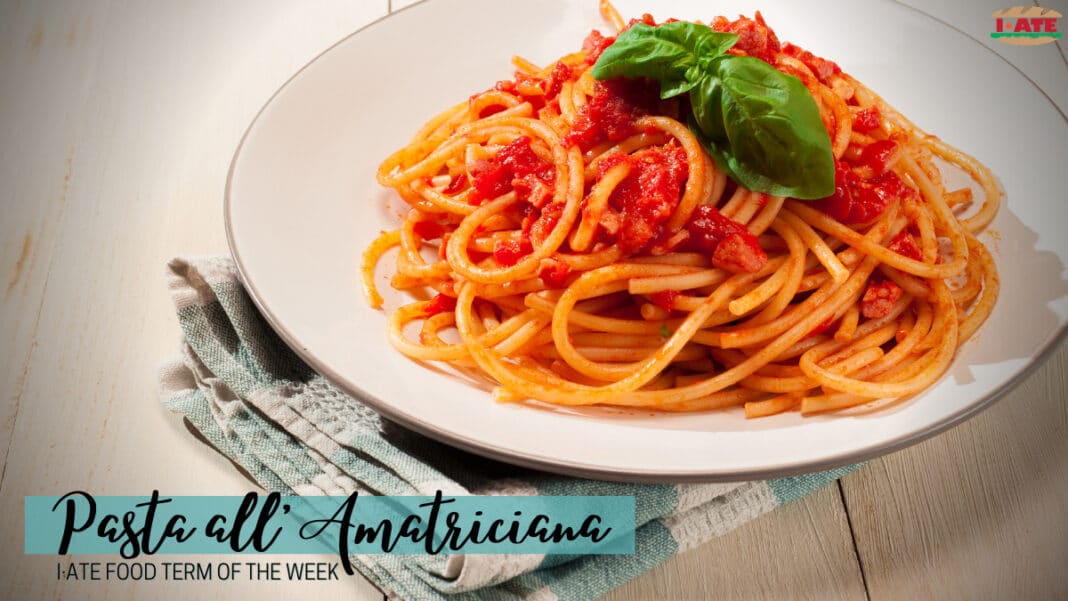Pasta all’amatriciana (or matriciana) is a typical dish served in Roman trattorias and taverns but it originally comes from the town of Amatrice, in the province of Rieti. Its main ingredients are basically three: pecorino cheese, pancetta (bacon) and tomato sauce. It seems certain that the addition of this latter element dates back to the end of the 1600s but there are many variations of the dish because a real recipe is difficult to trace.
In fact, it is a dish of peasant origin handed down mostly orally from generation to generation and, although several historical documents about amatriciana have survived, they are very often discordant. What is certain is that all the various additions provided by the various recipe books have enriched its flavour. However, in honour of the land that gave prestige to the amatriciana, here follows the recipe according to the tradition of Amatrice.
Pasta all’amatriciana originally had a white sauce and was called “pasta alla Gricia” (or Griscia, so-called after the town of Grisciano, near Amatrice). Centuries ago, the many shepherds who lived in the mountains surrounding Amatrice carried in their saddlebags the ingredients necessary for its preparation, including: pieces of bacon, pecorino cheese, lard, black pepper and dried pasta. Only later, with the seasonal shift of shepherds to the Roman countryside, was the tomato introduced in the preparation of the famous spaghetti all’amatriciana.
How to prepare Pasta all’Amatriciana?
Its recipe is based on a simple but at the same time meticulous preparation, both in the various steps and in the use of particular kitchen utensils, such as the iron pan used for cooking the sauce, essential to make an “authentic” matriciana.
- The real secret behind pasta all’amatriciana is the fat of the pancetta, the white and slightly pink part of the bacon. Pancetta, however, stands for guanciale, the ingredient that most of all connotes the amatriciana and which is obtained from the cured pork cheek and flavoured with a particular mix of spices. This needs to be cut into very fine and long strips, and never into cubes because you could risk hardening the lean part during cooking.
- The tomato sauce, on the other hand, must be made with fresh ripe tomatoes (casalino or San Marzano), cut into thin fillets, without seeds and left in a bowl with its juice. As for the pecorino cheese, another of the key ingredients of amatriciana, it is preferable not to use the Roman one as it is too salty and strong.
- The traditional recipe also does not include oil but a generous spoonful of lard to be heated over high heat strictly in the iron pan. Unlike common pans, in fact, the iron one is able to keep the flavour of the sauce unaltered.
- As soon as the lard has melted, you can add a whole red chilli pepper and the strips of bacon, to be mixed immediately using a wooden ladle. Lower the heat and wait a couple of minutes until the bacon has reached a golden-yellow colour: it is at this point that you have to stop the browning by adding the tomatoes with their juice.
- Cook for about 10 minutes, stirring the sauce from time to time and, after draining the cooked spaghetti, remove the chilli and pour the pasta into the pan with the sauce. Skip the pasta and gradually add the grated pecorino cheese that will serve as a binder with the other ingredients. At this point, your pasta all’amatriciana is ready to be served, but do not forget to add another final sprinkling of pecorino cheese.
The story goes that the merit of its diffusion is due to a courageous woman, a certain Anna De Angelis from Amatrice, who arrived in Rome with her “mappatella”, a capable haversack used by wayfarers, which contained homemade and dried pasta, slices of cured pork, pecorino cheese and wild herbs. She immediately began to prepare the original version of bucatini (type of pasta) with her very modest means: the first to appreciate it were the passing gardeners, soon joined by many other citizens of Amatrice, enthusiastic about the good country flavours of the dish prepared by the “Amatriciana” (the woman coming from Amatrice). And despite the fact that the “matriciani” (the inhabitants of Amatrice in the Roman mispronunciation), like all strangers to the city, were disliked by the Romans (they used to say “a strange guy has arrived who looks like a matriciano”), this specialty in no time earned the consent of all gourmets.Over time, the tomato was added, and the bucatini all’amatriciana were renamed as the “5 P’s dish”: pasta, pancetta (bacon), pomodoro (tomato), peperoncino (chilli), and pecorino (sheep’s milk cheese), to which in the Sixties Aldo Fabrizi, a very famous Roman actor, added a 6th P, with a witty remark in the Roman dialect: panza (the potbelly).
Sources
D’Achille Paolo, Viviani Andrea, “Cucina romana in bocca italiana. Fortuna nazionale di termini gastronomici romaneschi”, in Paolo D’Achille, Antonella Stefinlongo, Anna Maria Boccafurni (a cura di), Lasciatece parlà. Il romanesco nell’Italia di oggi, Roma, Carocci, 2012, pp. 273-287.
Faraoni Vincenzo, Loporcaro Michele (eds), “E parole de Roma” / “The Words of Rome”: Essays in Romanesco Etymology and Lexicology, De Gruyter, 2020, https://www.degruyter.com/view/title/529003.
Ortolani Cristina, L’Italia della pasta, Milano, Touring Club, 2003.
Written by Teresa Bifulco, PhD student in “European Languages and Specialized Terminology”, University of Naples “Parthenope” (Italy).

